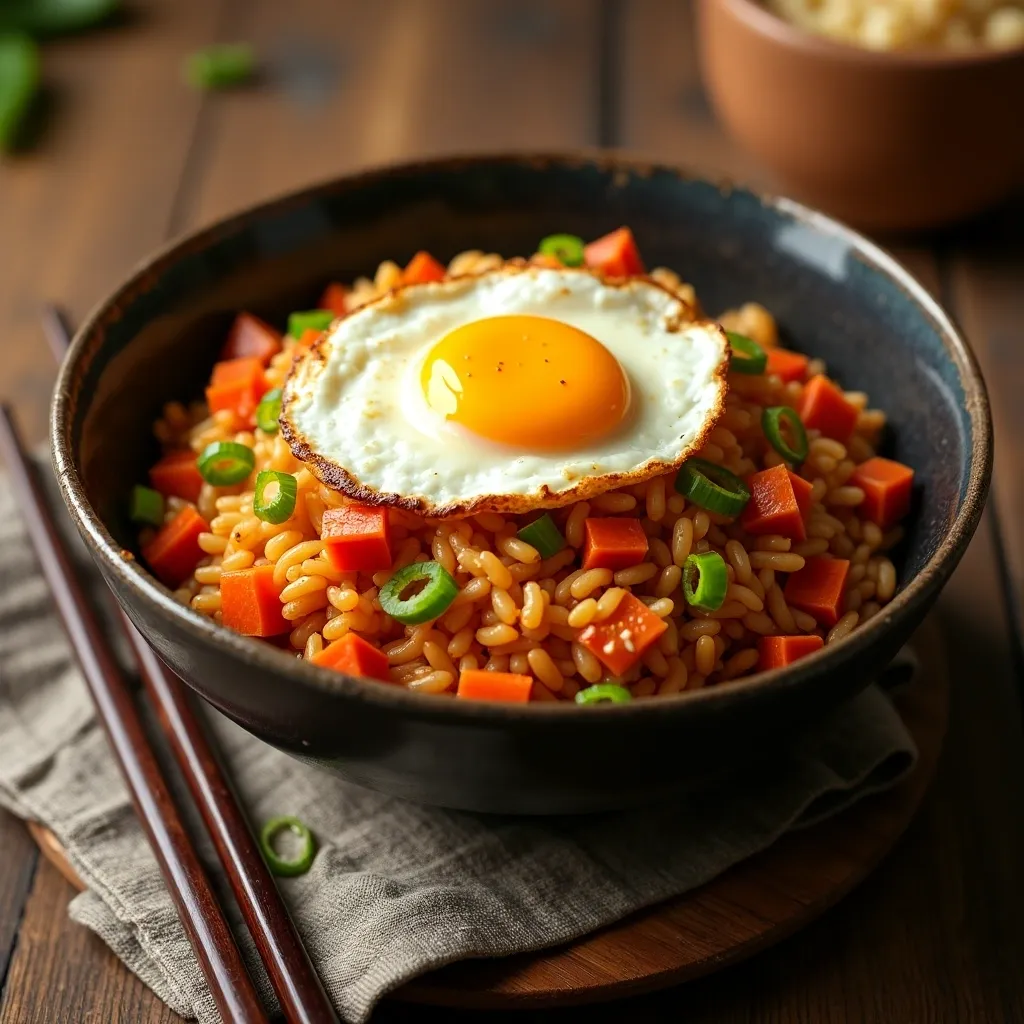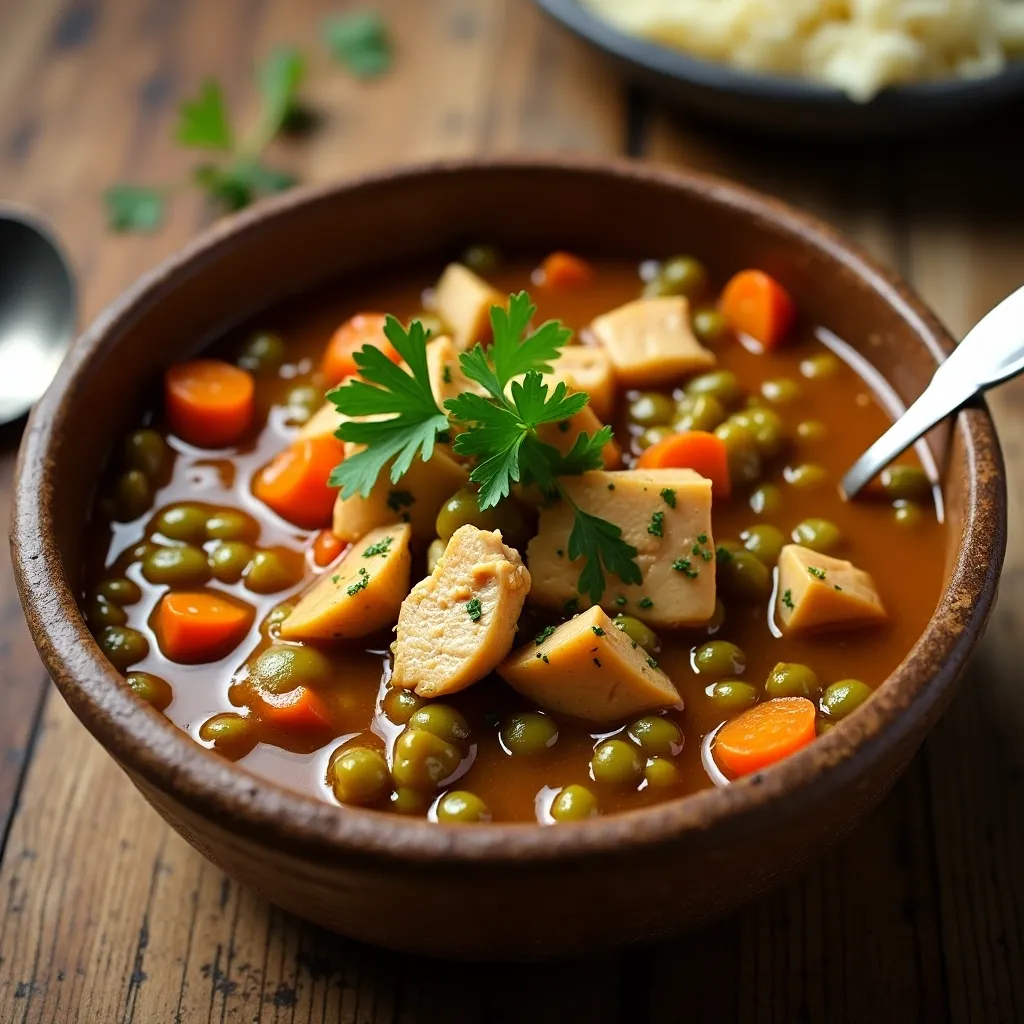The Gut Revolution – Probiotic-Rich Kimchi Fried Rice In This Article: Introduction In the intricate ecosystem of human health, the gut microbiome stands as a pivotal player, much like how a diverse ecosystem contributes to the overall health of our planet. Today, we embark on a culinary expedition that not only tantalizes the taste buds but also nurtures the complex world within our digestive system. Our mission: to craft a dish that serves as both a delicious meal and a support system for our gut health. The Gut-Brain Axis: A New Frontier Before we dive into our recipe, let’s examine the gut-brain connection through the lens of modern neuroscience and nutrition. Much like how the internet revolutionized global communication, the discovery of the gut-brain axis has transformed our understanding of mental and physical health. The gut, often referred to as our “second brain,” houses trillions of microorganisms that play crucial roles in digestion, immunity, and even mood regulation. This microbial community, when properly nurtured, acts as a formidable ally in our quest for overall well-being, much like how a well-functioning democracy relies on an informed and engaged citizenry. Kimchi: The Probiotic Powerhouse Enter kimchi, the star of our gut-friendly dish. This fermented Korean staple has risen from a regional delicacy to a global superfood, much like how K-pop has transcended cultural boundaries to become a worldwide phenomenon. Kimchi’s probiotic profile reads like a who’s who of beneficial bacteria: Lactobacillus species Leuconostoc species Weissella species By incorporating kimchi into our meal, we’re not just adding flavor; we’re introducing a diverse array of probiotics that can contribute to a healthier gut microbiome. This Probiotic Kimchi Fried Rice is a gut-friendly, flavorful dish packed with fermented kimchi, hearty brown rice, and crisp vegetables. Infused with sesame oil, tamari, and a spicy kick of gochugaru, it’s a perfect balance of tangy, savory, and umami flavors. Top it with a fried egg for extra richness! The Microbiome Perspective This dish is more than just a meal; it’s a microcosm of gut-friendly nutrition. The Kimchi Fried Rice represents a harmonious blend of probiotic and prebiotic elements: Kimchi provides live probiotic cultures Brown rice offers resistant starch, a prebiotic fiber Vegetables add diverse fibers and nutrients It’s a dish that tells the story of symbiosis on a plate, much like how a well-balanced ecosystem thrives on the interdependence of its various components. Conclusion As you savor each bite of this Probiotic-Rich Kimchi Fried Rice, consider the intricate dance of microorganisms taking place within your gut. This meal is not just satisfying your hunger; it’s feeding trillions of beneficial bacteria that, in turn, support your overall health. Remember, dear reader, that every meal is an opportunity to influence the complex ecosystem within you. In embracing gut-friendly cooking, we’re not just catering to a dietary trend; we’re participating in a broader conversation about holistic health, the mind-body connection, and the intricate web of life that exists within us. Stay tuned for our next culinary adventure, where we’ll continue to explore the fascinating intersection of nutrition, microbiology, and gastronomy. Until then, may your meals be as diverse and nurturing as the microbiome they support. Related Posts Share Post:
Gluten-Free Revolution – Quinoa Stuffed Bell Peppers
Gluten-Free Revolution – Quinoa Stuffed Bell Peppers In This Article: Introduction In the intricate tapestry of modern nutrition, gluten-free diets have emerged as a significant thread, weaving through medical necessities and lifestyle choices alike. Today, we embark on a culinary expedition that challenges the notion that flavor must be sacrificed at the altar of dietary restrictions. Our mission: to create a dish that stands as a testament to the power of thoughtful ingredient selection and skillful preparation. The Gluten-Free Paradigm: A Brief Analysis Before we dive into our recipe, let’s examine the gluten-free phenomenon through a lens of cultural and nutritional significance. Much like how the printing press revolutionized the dissemination of knowledge, the gluten-free movement has transformed our understanding of food sensitivities and celiac disease. Gluten, a protein found in wheat, barley, and rye, has been a staple in human diets for millennia. However, for a significant portion of the population, this ubiquitous protein poses a serious health risk. The rise of gluten-free options isn’t merely a trend; it’s a necessary evolution in our food system, akin to how societies adapt their infrastructure to accommodate diverse needs. Quinoa: The Gluten-Free Superhero Enter quinoa, our protagonist in this culinary narrative. This pseudo-cereal, once a staple of ancient Andean civilizations, has risen to prominence in the modern health food landscape. Its ascension mirrors that of a classic underdog story: from obscurity to global recognition, much like how indie films sometimes capture the zeitgeist and become cultural phenomena. Quinoa’s nutritional profile reads like a superhero’s resume: Complete protein (containing all essential amino acids) High in fiber Rich in minerals like iron and magnesium Gluten-free By choosing quinoa as our base, we’re not just avoiding gluten; we’re actively enhancing the nutritional value of our meal. These Quinoa Stuffed Bell Peppers are a flavorful, nutritious, and satisfying dish packed with protein-rich quinoa, black beans, sweet corn, and warm spices. Topped with melted cheese and fresh cilantro, they make a perfect wholesome meal or side dish! The Cultural Significance This dish is more than just a meal; it’s a microcosm of our evolving relationship with food. The quinoa stuffed bell peppers represent a harmonious blend of global influences: Quinoa from South America Bell peppers, native to Central and South America but now global Spices that span continents It’s a dish that tells the story of globalization on a plate, much like how a well-crafted film can capture the essence of an era. Conclusion As you savor each bite of these Quinoa Stuffed Bell Peppers, consider the journey of ingredients, the science of nutrition, and the cultural shifts that have made this meal possible. It’s a testament to human ingenuity and adaptability, a delicious argument for the power of inclusive culinary practices. Remember, dear reader, that every meal is an opportunity to nourish not just your body, but your understanding of the world. In embracing gluten-free cooking, we’re not just catering to dietary needs; we’re participating in a broader conversation about health, sustainability, and cultural exchange. Stay tuned for our next culinary adventure, where we’ll continue to explore the intersection of nutrition, culture, and creativity. Until then, may your meals be as diverse and enlightening as the world around us. Related Posts Share Post:
The Power of Protein: Chicken and Lentil One-Pot Wonder
The Power of Protein: Chicken and Lentil One-Pot Wonder In This Article: Introduction In the complex landscape of nutrition, protein stands as a fundamental pillar of health, much like how a strong foundation supports a towering skyscraper. Today, we’re delving into the world of high-protein meals, exploring not just a recipe, but the science and strategy behind incorporating more protein into your diet. Why High-Protein Meals Matter Muscle Maintenance and GrowthProtein is the building block of muscle tissue. Whether you’re an athlete or simply trying to maintain muscle mass as you age, adequate protein intake is essential.Satiety and Weight ManagementProtein-rich meals keep you feeling fuller for longer. This can be a powerful tool in managing appetite and supporting weight loss efforts.Metabolic Boost The thermic effect of food (TEF) is highest for protein, meaning your body burns more calories digesting protein compared to fats or carbohydrates.Recovery and Repair Protein is crucial for repairing tissues, supporting immune function, and aiding in recovery after exercise or injury. When to Prioritize High-Protein Meals Post-Workout Consuming protein within 30 minutes to 2 hours after exercise can help with muscle recovery and growth. Breakfast Starting your day with a protein-rich meal can improve satiety and help maintain stable blood sugar levels throughout the day. During Weight Loss Increasing protein intake while in a calorie deficit can help preserve muscle mass. Growth and Aging As we age and during periods of growth, our bodies require more protein—whether to maintain muscle mass and strength in older adults or to support the rapid development of adolescents and pregnant women. Now, let’s put theory into practice with our Chicken and Lentil One-Pot Wonder – a protein powerhouse that’s as nutritious as it is delicious. The Chicken and Lentil – One Pot Wonder dish is a protein powerhouse, combining two excellent sources: chicken and lentils. The chicken provides all essential amino acids, making it a complete protein source. Lentils, while not a complete protein on their own, offer a substantial protein boost along with fiber and various micronutrients. The Protein Perspective This dish is a protein powerhouse, combining two excellent sources: chicken and lentils. The chicken provides all essential amino acids, making it a complete protein source. Lentils, while not a complete protein on their own, offer a substantial protein boost along with fiber and various micronutrients. When we pair these protein sources with a variety of vegetables and aromatic spices, we’re not just creating a meal – we’re orchestrating a symphony of nutrition. The vegetables provide essential vitamins, minerals, and fiber, while the spices offer potential anti-inflammatory benefits. Beyond the Plate Remember, incorporating high-protein meals into your diet is just one piece of the health puzzle. It’s part of a broader strategy, much like how a single policy change is part of a larger governmental reform. Regular physical activity, adequate hydration, and overall balanced nutrition all play crucial roles in optimizing your health and well-being. As you savor each spoonful of this Chicken and Lentil One-Pot Wonder, consider the complex interplay of nutrients at work in your body. It’s a reminder that every meal is an opportunity to nourish yourself, to provide your body with the tools it needs to function at its best. In a world where food choices can often feel overwhelming or confusing, dishes like this serve as a beacon of simplicity and nutrition. They remind us that eating well doesn’t have to be complicated or time-consuming. Sometimes, the most powerful changes come from the simplest actions – like choosing to prioritize protein in our meals. Stay tuned for our next installment, where we’ll continue to explore the intricate world of nutrition and how it intersects with our daily lives. Until then, may your meals be nourishing, your energy levels high, and your curiosity for health and wellness ever-growing. Related Posts Share Post:
Zesty Lemon Herb Chicken with Quinoa
Zesty Lemon Herb Chicken with Quinoa In This Article: Introduction Discover a simple yet flavorful anti-inflammatory dish designed for beginner chefs! This Zesty Lemon Herb Chicken with Quinoa is a one-pan recipe that’s easy to prepare, packed with wholesome ingredients, and perfect for those looking to create a healthy meal without stress. This Zesty Lemon Herb Chicken with Quinoa is a vibrant and nutritious dish featuring juicy, herb-seasoned chicken paired with fluffy quinoa, fresh spinach, and cherry tomatoes, all brightened with a zesty lemon kick. Perfect for a wholesome and satisfying meal. Why This Recipe? LemonA great source of vitamin C, it adds a zesty flavor while supporting your immune system.QuinoaA complete protein and rich in fiber, it’s a fantastic base for this dish.Spinach and TomatoesPacked with antioxidants and nutrients, these ingredients round out the meal. Related Posts Share Post:




